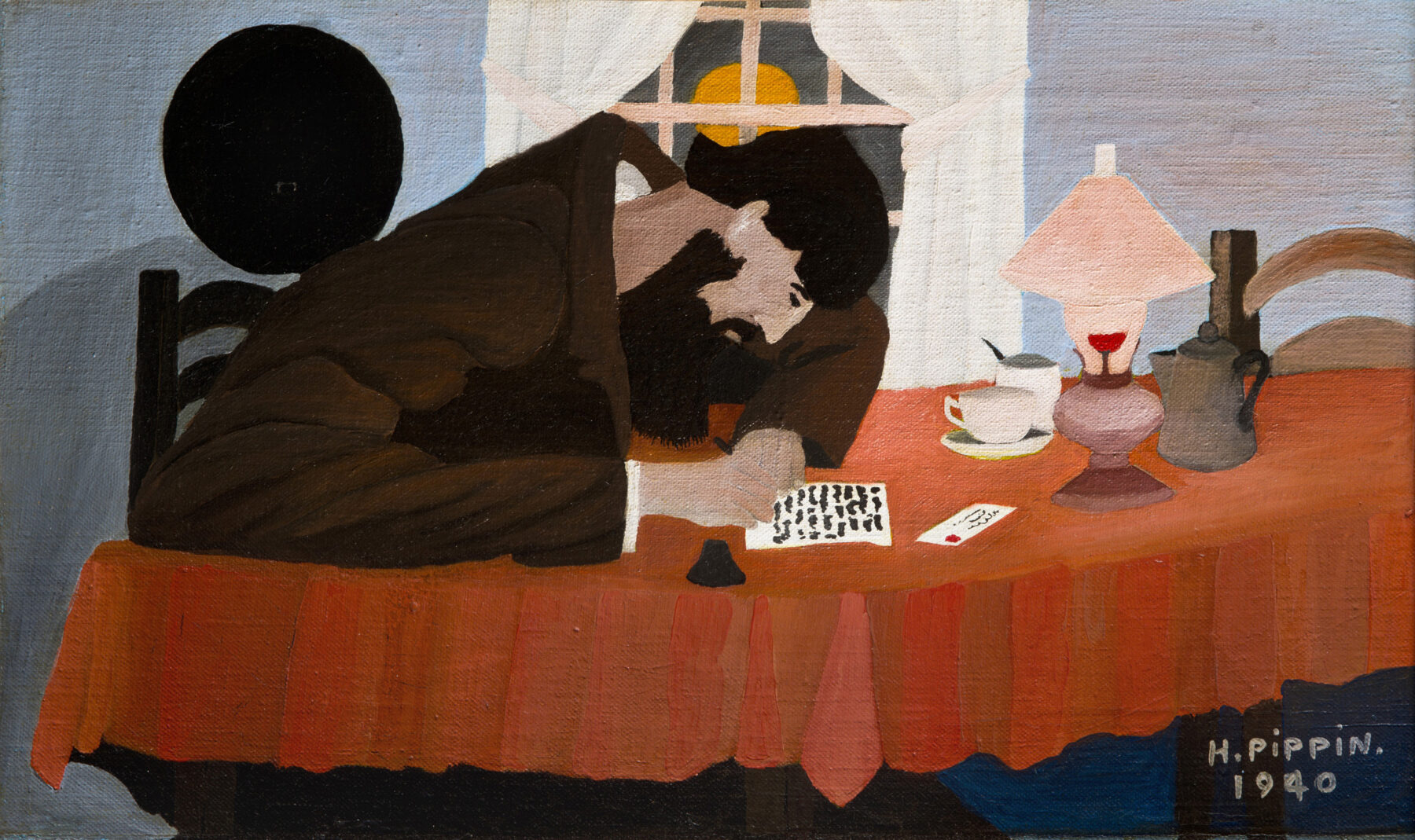Horace Pippin
Horace Pippin was born in West Chester, Pennsylvania, and spent most of his childhood in Goshen, New York. With no formal art education or training, he began creating art as a child using crayons he won in an art contest. Pippin was forced to leave school to support his sick mother and worked various unskilled jobs. In 1917, he enlisted in the 15th regiment of the New York National Guard, an all-black unit that served in active duty in France. Pippin was shot by a sniper in his right shoulder, disabling his arm. Following the war, Pippin married and returned to his hometown of West Chester in 1920 where he returned to his interest in art. His disability prevented him from performing manual labor, so Pippin worked odd jobs and painted cigar boxes to engage his creativity. Pippin painted his first oil painting in 1928 and made only a small number each year for the next decade.
Pippin was discovered by illustrator NC Wyeth and art critic Christian Brinton, who arranged his first solo exhibition at the West Chester Community Center in 1937. In 1938, he attracted national attention when four of his paintings were shown in the Museum of Modern Art’s traveling exhibition Masters of Popular Painting. The following year, Pippin met the Philadelphia gallery owner Robert Carlen, who became his dealer. Success continued when Pippin was introduced to Dr. Albert C. Barnes, the visionary collector who bought several of his works from Carlen’s gallery. Pippin continued to receive attention from museums, collectors and dealers over the next several years; the San Francisco Museum of Art, the Pennsylvania Academy of Art, The Corcoran Gallery, The Newark Museum and the National Gallery of Art all exhibited his work during the 1940s.
Pippin lived near Lancaster County, a center of the Pennsylvania Amish community when he painted Amish Letter writer in 1940. The artist drew his subject matter primarily from the activities of small-town life and likely found the inspiration for the painting in Lancaster. He had little use for those who suggested he seek formal artistic training, preferring to embrace his own method, painting each work on the basis of images visualized in his head with no preparatory drawings or sketches. Due to his injury from World War I, Pippin had limited mobility of his right arm, so he used small canvases, which offer an intimate glimpse into the world of his imagination. He built his scenes of areas of color using very little perspective, resulting in a graphic quality that set his work apart from that of his contemporaries.
Selden Rodman writes, “In ‘Amish Letter Writer’ Pippin demonstrated anew his unerring instinct for abstract design, and the capacity, never sacrificed with growing sophistication and skill, to return to an earlier ‘style’ whenever the mood of the picture required a starker simplicity of means. In this picture the long bent back of the scribe completes the central darkness of the window behind him. Lampshade and inkwell repeat the night’s checkered pyramid. The moon, illuminated but not illuminating, takes its place with teacup, pitcher and chimney in proper equality of value. The eye focuses, as it should, on the black hieroglyphics of the white sheet beneath the writer’s hand.” (Horace Pippin: A Negro Painter in America, New York, 1947, p. 16)
Horace Pippin was born in West Chester, Pennsylvania, and spent most of his childhood in Goshen, New York. With no formal art education or training, he began creating art as a child using crayons he won in an art contest. Pippin was forced to leave school to support his sick mother and worked various unskilled jobs. In 1917, he enlisted in the 15th regiment of the New York National Guard, an all-black unit that served in active duty in France. Pippin was shot by a sniper in his right shoulder, disabling his arm. Following the war, Pippin married and returned to his hometown of West Chester in 1920 where he returned to his interest in art. His disability prevented him from performing manual labor, so Pippin worked odd jobs and painted cigar boxes to engage his creativity. Pippin painted his first oil painting in 1928 and made only a small number each year for the next decade.
Pippin was discovered by illustrator NC Wyeth and art critic Christian Brinton, who arranged his first solo exhibition at the West Chester Community Center in 1937. In 1938, he attracted national attention when four of his paintings were shown in the Museum of Modern Art’s traveling exhibition Masters of Popular Painting. The following year, Pippin met the Philadelphia gallery owner Robert Carlen, who became his dealer. Success continued when Pippin was introduced to Dr. Albert C. Barnes, the visionary collector who bought several of his works from Carlen’s gallery. Pippin continued to receive attention from museums, collectors and dealers over the next several years; the San Francisco Museum of Art, the Pennsylvania Academy of Art, The Corcoran Gallery, The Newark Museum and the National Gallery of Art all exhibited his work during the 1940s.
Pippin lived near Lancaster County, a center of the Pennsylvania Amish community when he painted Amish Letter writer in 1940. The artist drew his subject matter primarily from the activities of small-town life and likely found the inspiration for the painting in Lancaster. He had little use for those who suggested he seek formal artistic training, preferring to embrace his own method, painting each work on the basis of images visualized in his head with no preparatory drawings or sketches. Due to his injury from World War I, Pippin had limited mobility of his right arm, so he used small canvases, which offer an intimate glimpse into the world of his imagination. He built his scenes of areas of color using very little perspective, resulting in a graphic quality that set his work apart from that of his contemporaries.
Selden Rodman writes, “In ‘Amish Letter Writer’ Pippin demonstrated anew his unerring instinct for abstract design, and the capacity, never sacrificed with growing sophistication and skill, to return to an earlier ‘style’ whenever the mood of the picture required a starker simplicity of means. In this picture the long bent back of the scribe completes the central darkness of the window behind him. Lampshade and inkwell repeat the night’s checkered pyramid. The moon, illuminated but not illuminating, takes its place with teacup, pitcher and chimney in proper equality of value. The eye focuses, as it should, on the black hieroglyphics of the white sheet beneath the writer’s hand.” (Horace Pippin: A Negro Painter in America, New York, 1947, p. 16)
Horace Pippin
Amish Letter Writer, 1940
Oil on canvas
12″ x 20″
Signed and dated lower right
Provenance
Robert Carlen Galleries, Philadelphia, Pennsylvania
Mr. and Mrs. Samuel L. Feldman, Philadelphia, Pennsylvania
Fleisher/Ollman Gallery, Philadelphia, Pennsylvania June Kelley Gallery, New York Private Collection, Michigan, acquired from the above in 2000

